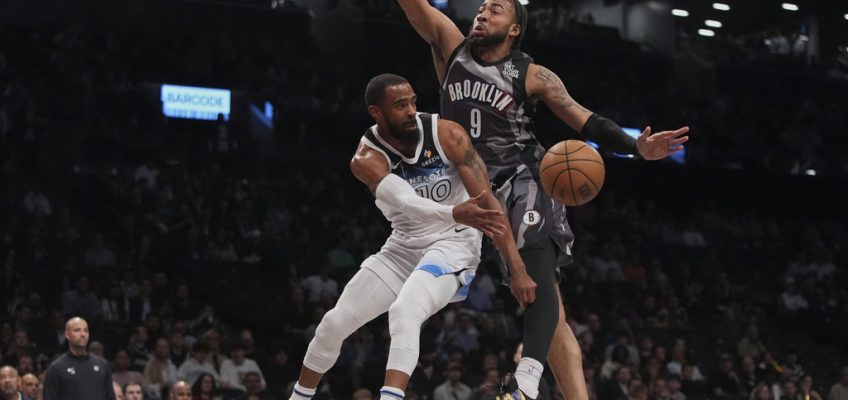A Picasso, Thursday’s game in Brooklyn was not.
After edging Denver in perhaps the game of the NBA season on Tuesday, Minnesota played one that will be remembered by approximately no one on Thursday.
But it will go down in the books as Minnesota’s fourth straight win, as the Wolves pushed through Thursday’s game to top the depleted Nets 105-90.
“Pushed through is probably the right verb,” Wolves coach Chris Finch told reporters. “It didn’t feel like we had a ton of gas in the tank, understandable after the other night and the trip across (the country).”
And all wins count the same, particularly at this point in the season. The Wolves started the day in sixth place in the Western Conference standings, a desirable spot considering the top six avoid the play-in tournament.
But more and more appears to be on the table for the Wolves with each passing day. Can Minnesota pass Denver for a top-four seed and home-court advantage? It’s all in play if the Wolves run the table.
“We’re locked in. We know that every game is huge,” Center Rudy Gobert said in his postgame, on-court television interview. “Every day in practice, in film, everything we do, we can feel that everyone is locked in, and we’re taking it one game at a time and taking care of business.”
The assumption is the Wolves won’t be able to do that in each of their final five games, even with one of the league’s most favorable remaining schedules. Because it’s easy to slip up on any night amid a non-stop NBA schedule, even against a Brooklyn (25-52) team missing countless members of its usual rotation.
The Wolves have lost a number of games this season they should not have when gauging the matchup on paper.
But inconsistency has been this team’s curse.
Luckily for Minnesota (45-32), its antidote for the ailment appears to be rounding into form. Gobert was Minnesota’s most consistent player a year ago. He’s looking a lot like that again of late.
“He’s been playing his (butt) off,” Anthony Edwards said in a brief cameo during Gobert’s interview.
Gobert tallied 21 points and 18 rebounds in Thursday’s victory. Over his last six games, the center is averaging 17.8 points and 15.7 rebounds. Minnesota’s record in that span is 5-1.
“I feel great,” Gobert said. “I try to set the tone for the team every night and keep raising my level, and try to do it every minute I’m on the floor.”
That interior dominance isn’t dependent on shots falling.
So, it didn’t matter that Minnesota made just 31% of its 3-point attempts on Thursday. And the Wolves’ 18 turnovers — which led to 20 Nets’ points going the other way — were somewhat negated by the team’s 10 offensive rebounds resulting in 16 second-chance points.
“He looks like the Defensive Player of the Year that he was last year. Consistently challenging everything, finishing really well, playing strong offensively around the rim, playing very smart when the ball is delivered to him,” Finch said. “He’s playing within himself but at a high level.”
It’s a constant upon which the Wolves can rely on to win as many of their final five games and climb as high as they can in the Western Conference standings. And, perhaps more importantly, Gobert at this level of dominance could be the key to any number of potential playoff matchups for Minnesota.
It may not always be pretty, but it sure is effective. All that matters is what comes in April and May in the NBA.
Ant scare
Anthony Edwards finished with a team-high 28 points on an efficient 10-for-15 shooting from the field. He was helped to the locker room in the second quarter after twisting his ankle when landing on the foot of Nets coach Jordi Fernández on a corner 3-point attempt.
But, as is often the case for Edwards, he returned at the start of the second half and was no worse for wear.
“A little dramatic, he likes to do that,” Gobert joked. “But it’s great. He’s tough. We know he’s going to play through a lot, and he loves to compete. We love that about him.”
Related Articles
0 for 14 … and counting: Timberwolves’ wild win in Denver again put end-of-game struggles on display
Taylor cedes Timberwolves and Lynx ownership to Rodriguez, Lore
Timberwolves win wild, wild double-overtime affair in Denver
Can Timberwolves avoid play-in tournament? A guide to Minnesota’s playoff prospects
Donte DiVincenzo, Naz Reid suspended for Wolves game Tuesday in Denver




